The Hisense U6NQ is a really interesting model from the Chinese manufacturer. It is the first MiniLED from the 2024 series and the only one with a refresh rate of 60 Hz. Starting with the picture quality, the MiniLED backlight combined with the VA matrix does its job – the contrast is good, and watching movies in the evening is a pleasure. Stable HDR performance, support for Dolby Vision and HDR10+, and solid colours make the TV handle most everyday tasks well. The Vidaa system works efficiently – it is fast and intuitive, without annoying stutters. A few popular apps, such as Spotify and Tidal, are missing, but most users will find what they need here, including the ability to record programs to a flash drive or external hard drive. And what about motion smoothness? It's quite decent. The option to choose between 4K at 60 Hz and Full HD at 120 Hz is a nice addition, especially if we play on consoles that often do not offer perfect 4K at 120 frames. Features such as VRR and ALLM further enhance the comfort of occasional gaming. However, it is not without its drawbacks. There are visible smearing issues in dynamic scenes, and the lack of any function to reduce this effect does not help. In terms of picture quality, this TV heavily prioritizes brightness, which sometimes leads to situations where black takes on a slight bluish hue in difficult conditions. In short: the Hisense U6NQ is a good choice for those looking for a TV that offers good picture quality and a comfortable operating system. It is not a device without compromises, but in its price range, it performs really well.
- Matching (Score)
- Our verdict
- TV appearance
- Where to buy
- Contrast and black detail
- HDR effect quality
- Factory color reproduction
- Color reproduction after calibration
- Smoothness of tonal transitions
- Image scaling and smoothness of tonal transitions
- Blur and motion smoothness
- Console compatibility and gaming features
- Input lag
- Compatibility with PC
- Viewing angles
- TV efficiency during daytime
- Details about the matrix
- TV features
- Apps
- Playing files from USB
- Sound
Hisense U6NQ vs Samsung The Frame 2025 (LS03F)
Direct compare
Check the best price offer:
Hisense U6NQCheck the best price offer:
Samsung The Frame 2025 (LS03F)The Frame / LS03FAU


Panel type: LCD VA
Resolution: 3840x2160
System: VIDAA
Model year: 2024
Complete the survey to find out the result

Panel type: LCD VA
Resolution: 3840x2160
System: Tizen
Model year: 2025
Complete the survey to find out the result

Overall rating
6.6
7.0
Movies and series in UHD quality
6.6
6.7
Classic TV, YouTube
6.5
6.5
Sports broadcasts (TV and apps)
5.0
6.4
Gaming on console
7.1
8.3
TV as a computer monitor
6.0
8.2
Watching in bright light
6.1
6.3
Utility functions
9.0
8.0
Apps
8.6
8.3
Sound quality
6.3
6.0
Complete the survey to find out what fits your preferences
Advantages
Good contrast and black in its price class
Support for multiple HDR formats - Dolby Vision, HDR 10+
Correct color reproduction out of the box
Flexible refresh rate - 4K@60Hz or FullHD@120Hz
Decent for occasional gaming - low input lag, ALLM, VRR
Recording to USB from built-in tuners
The matte display effectively reduces reflections
Customization options for the screen with interchangeable frames + art mode
Free accessories in the form of a wall mount + OneConnect module
High native contrast
Decent brightness
High refresh rate - 120/144Hz
Lots of features for gamers - VRR, ALLM, Gamebar, proprietary motion smoother working in games
Disadvantages
Missing several applications in the VIDAA system - Spotify or Tidal
Issues with motion blur
Dimmer algorithms work average
No HGiG mode – makes it difficult to set HDR accurately on the console.
No DTS support – requires additional equipment for certain films from Blu-ray discs.
Paid image mode
Our verdict
Samsung The Frame 2025 is a TV unlike any other – and even though competition has emerged for it, it still does it best. The matte display, flush mounting to the wall, and one thin cable thanks to the One Connect module make the device look more like a painting than any other screen. The Art Store app still offers the best scanned artwork on the market (even if it's subscription-based), and with interchangeable frames, we can adapt the TV to the interior almost like a piece of furniture. As for the image itself, because we are also talking about a regular TV, there are no significant changes, but also no disappointments compared to last year's model LS03D. The Frame still offers high native contrast and solid brightness at 600 nits, which combined with the matte coating provides very comfortable use during the day. The colors are not as vibrant as on glossy screens, but against the backdrop of competing matte constructions – it performs the best. A novelty is the 144 Hz refresh rate, though in practice, mainly PC gamers will benefit from it. And indeed – in terms of features for gamers, The Frame has almost everything: low input lag, variable refresh rate (VRR) support, automatic game mode (ALLM), Game Bar, and a unique motion smoother designed for gaming. Unfortunately, not everything is as perfect as it might seem. Why? Because the HGiG mode is suddenly missing from the latest version of the Tizen system. And here Samsung really should respond, as for many gamers this is a crucial element of screen selection. And we fully understand that. Although LS03F The Frame 2025 doesn’t bring major revolutions, it is still a unique TV that, apart from its appearance, offers quite a solid picture and extensive gaming features. It’s just a shame that year after year we also encounter new compromises.
TV appearance





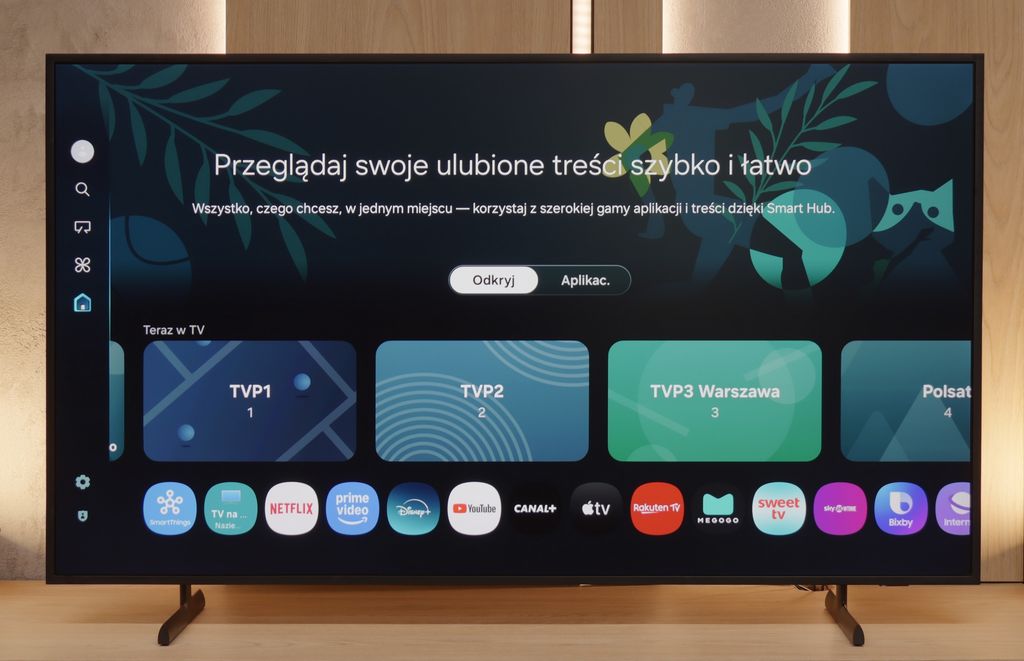
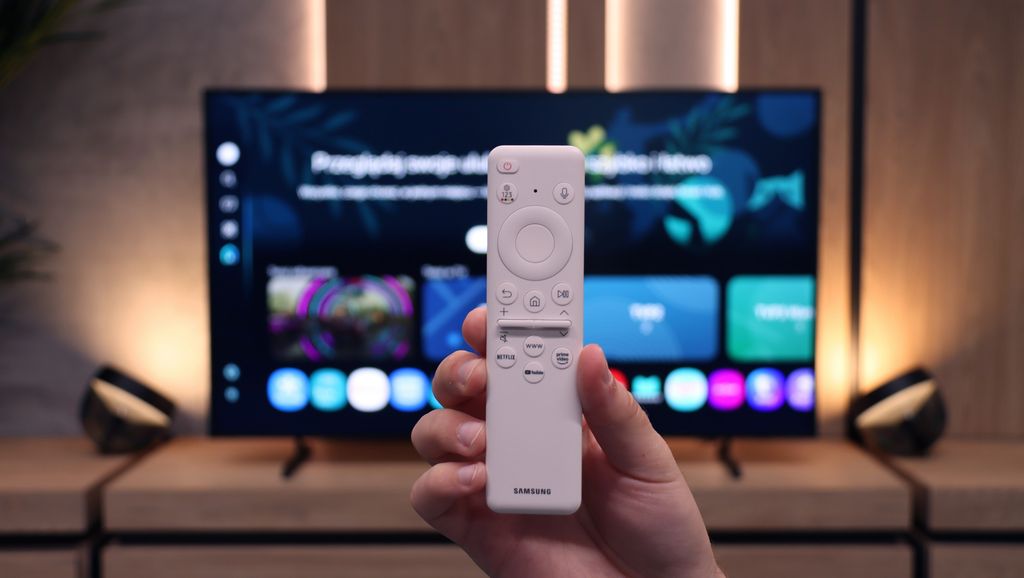

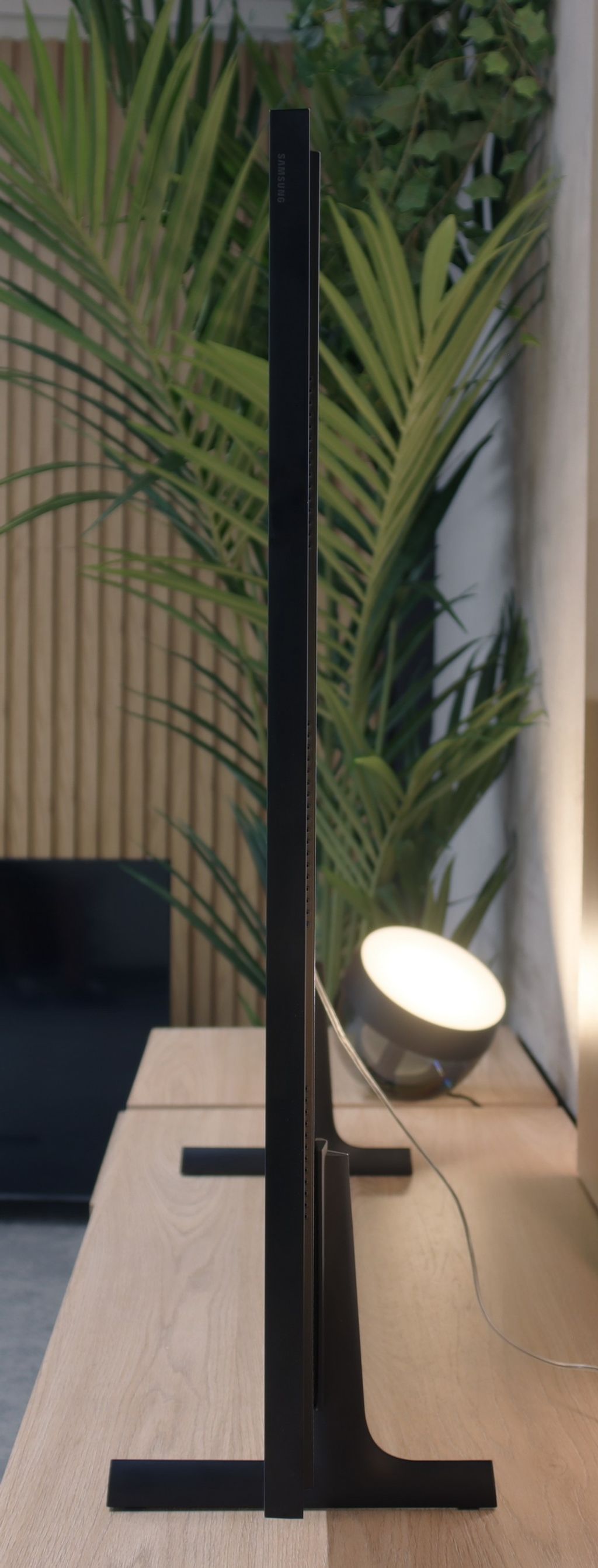
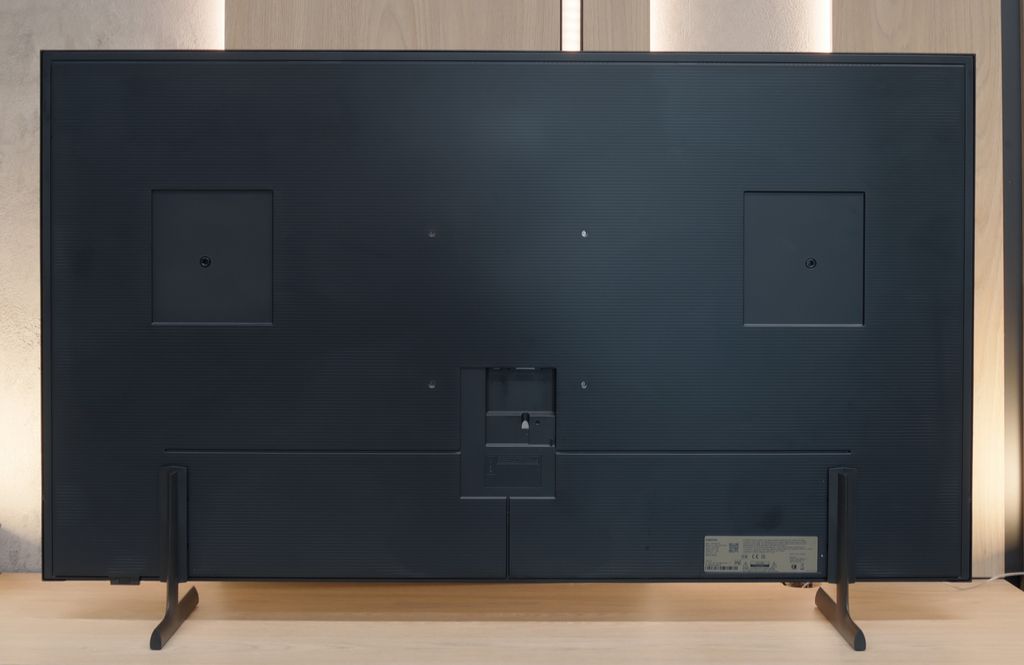
Where to buy
Contrast and black detail
7/10
6/10
Local dimming function: Yes, number of zones: 160 (20 x 8)
Local dimming function: No
Contrast:

Result
61,250:1

Result
13,650:1

Result
14,700:1

Result
11,150:1

Result
5,800:1

Result
4,800:1

Result
4,750:1

Result
14,900:1

Result
4,500:1

Result
4,300:1
Halo effect and black detail visibility:

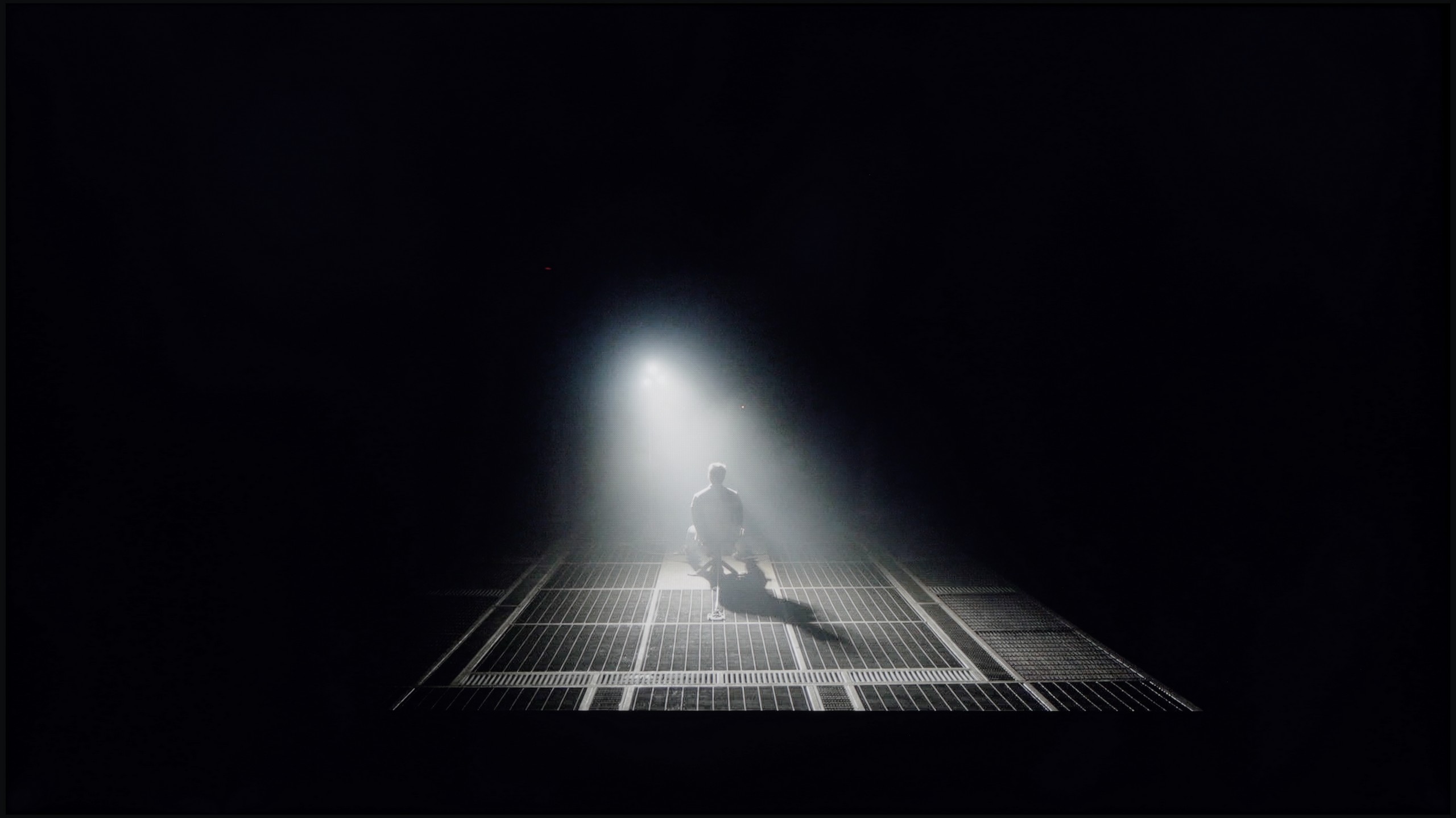
The tested 55-inch model has a VA panel, providing deeper blacks compared to IPS/ADS panels. This technology alone ensures that contrast reaches quite a decent level. It is also worth noting that the Hisense U6NQ, as a MiniLED technology television in this version, has 160 local dimming zones, which significantly improves image quality in many scenes. During tests, for example in the movie Oblivion, the television demonstrated good separation of the hologram lights, while the contrast remained satisfactory. Unfortunately, in more demanding materials, such as the Pioneer Kuro test pattern, a noticeable drop in quality was observed. In such scenes, the dimming zones did not work correctly, leading to a significant reduction in contrast. Similar issues occurred in scenes from the movie Sicario 2, where the blooming effect was clearly visible, indicating the television's difficulties with precise management of the backlight zones. Despite these shortcomings, the overall level of contrast in the U6NQ can be considered solid, especially in this price category. The television performs well in most standard scenes, and its capabilities in displaying blacks are better than those of models with other types of panels.
The year 2025 looks quite interesting when it comes to lifestyle TVs. Why? Because Samsung has prepared two versions of the iconic model The Frame – one regular and another with the "Pro" label. In this review, we take a look at the version without "Pro," which – as will soon become evident – is quite significant. The regular model LS03F does not feature any local dimming technology, unlike its more expensive sibling. This is important because it affects not only the overall picture quality but primarily how this TV handles black levels.
The VA panel used in The Frame 2025 has a high native contrast – and this obviously works to its advantage. In the tested movie scenes, details in the dark parts of the image were clearly visible; nothing blended together, and it didn’t create a uniform black/bright spot. For the average viewer, this will be more than sufficient. But of course, not everything is perfect. The lack of local dimming causes the black levels on this TV not to be perfectly deep – it resembles a dark navy more than pitch black. Additionally, in our tested unit, we noticed slight backlighting in the right part of the screen, but this may just be the "beauty of the specimen" rather than a rule. Theoretically, one could try to improve the perception of blacks by backlighting the screen – for example, with an LED strip – but in the case of The Frame, this is rather impossible because this TV is meant to sit flush against the wall like a painting. So to achieve better blacks visible to our eyes, we are forced to watch the LS03F with the lights on. Such is the charm of this technology.
HDR effect quality
5.4/10
5.8/10
Luminance measurements in HDR:

Result
443 nit

Result
426 nit

Result
505 nit

Result
442 nit

Result
448 nit

Result
642 nit

Result
589 nit

Result
574 nit

Result
584 nit

Result
631 nit
Scene from the movie “Pan” (about 2800 nits)


Scene from the movie “Billy Lynn” (about 1100 nits)


Static HDR10


Dynamic: Dolby Vision
Dynamic: HDR10+


HDR luminance chart:
Samsung The Frame 2025 (LS03F)
Luminancja HDR
Luminance of RGB colors
Hisense U6NQ
Luminancja HDR
Luminance of RGB colors
Hisense U6NQ offers a stable HDR effect, which is rare in TVs with local dimming. On most streaming platforms, in movies and series recorded in 4K, the TV presents consistent performance – in every tested scene, regardless of difficulty level, brightness is around 450 nits. This is a pleasant surprise, as many models in this class show significant differences – some scenes are well-lit, while others are heavily dimmed by dimming algorithms. However, Hisense U6NQ prioritizes maintaining higher brightness, which comes at the expense of black levels, as mentioned in the paragraph about contrast testing.
The HDR effect on the U6NQ is satisfying, offering a noticeable "hit" of light in bright moments, although it is worth remembering the previously mentioned blooming, which can be visible in more challenging scenes. In terms of colours, the TV also performs decently – the coverage of the DCI-P3 palette is 89%, and BT.2020 is 71%. Although these are not results that would impress more demanding users, for beginners in the world of high-quality content, the U6NQ serves as a solid choice. Thus, it presents an interesting option as an "entry-level" TV for home cinema.
The Frame LS03F is a television that can surprise with its brightness. The maximum luminance reaches around 650 nits, which already looks solid on paper. But as we know, lab tests are one thing, and real movie scenes tell a completely different story. When watching HDR content in natural conditions, The Frame 2025 maintains very good results. In most film scenes, peak brightness remained at levels of 550–650 nits. This is enough to feel the difference between standard image quality and that of HDR – bright highlights, reflections on water, and moonlight appear clear and impressive.
It’s also worth noting that the LS03F is a QLED television, which translates to solid color saturation. The coverage of the DCI-P3 color space reaches about 92%, allowing for vibrant, intense colors in HDR content. It may not be at the level of top premium models, but for a lifestyle screen, the result truly deserves recognition.
Factory color reproduction
8/10
7.1/10


Factory Mode
After calibration

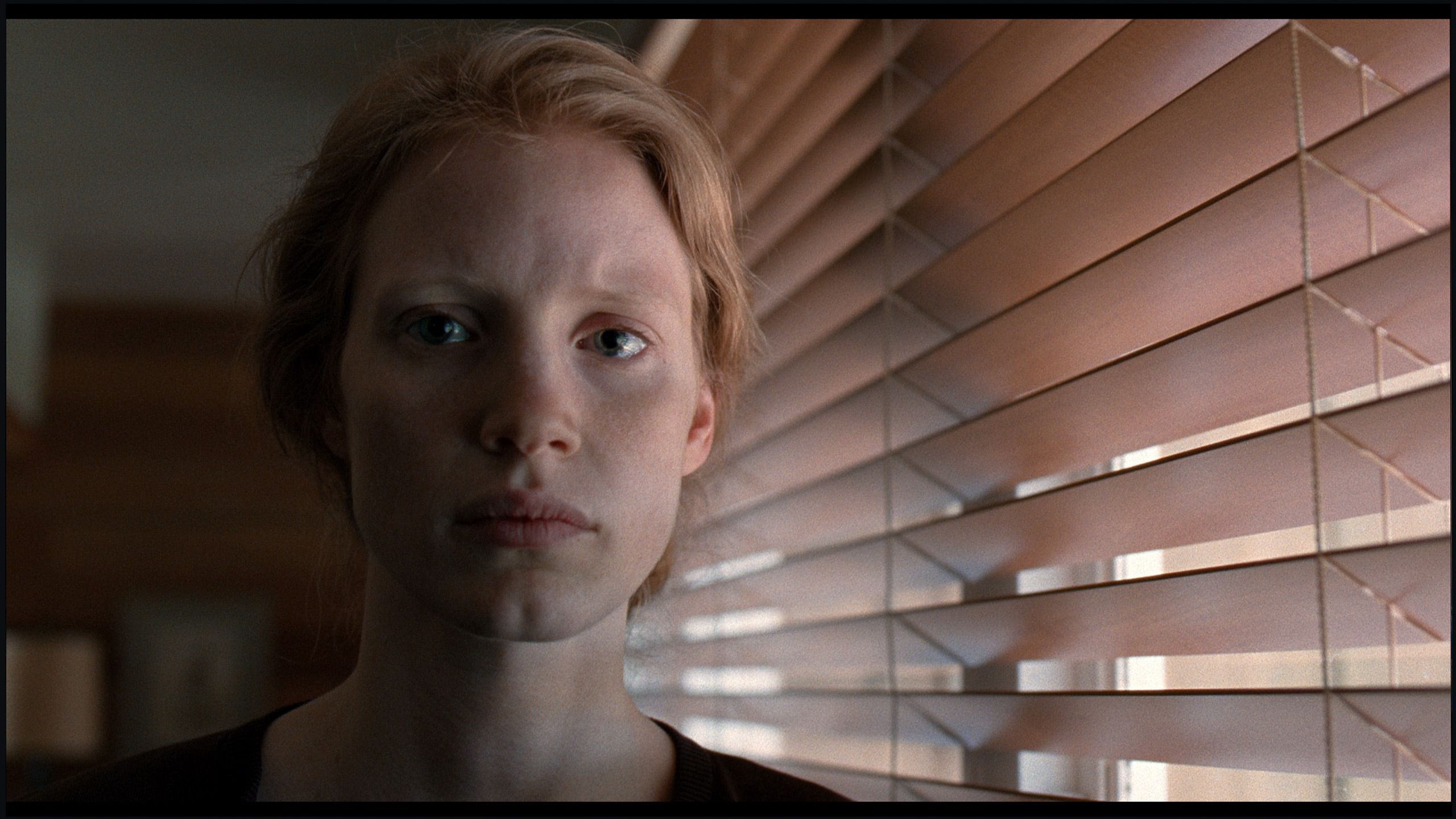
Factory Mode
After calibration
The Hisense U6NQ in Filmmaker mode offers truly decent colour reproduction, although it is worth noting that differences between individual units can be noticeable. The model we tested surprised us positively, especially with HD content in SDR quality. The white balance was correct, and errors around 3–4 ΔE should be acceptable for the average viewer. The TV performed slightly worse in colour reproduction with 4K HDR materials. The dominance of blue hues led to unnatural cool tones on the Colour Checker chart, giving the picture a "store-bought" character. Combined with issues in brightness characteristics – gamma and EOTF curve caused some parts of the image to be too dark – the Filmmaker mode loses some of its credibility in this case. Although the factory settings of the tested unit deserve praise, especially in SDR, there were still minor shortcomings that would require adjustment to fully leverage the capabilities of the TV.
When it comes to image quality right out of the box, even in Filmmaker mode, which is supposed to be the closest to reference, there were issues. In both HD and 4K HDR content, we noticed noticeable deviations in white balance. The image was heavily skewed towards red and blue, giving the screen a characteristic rosy tint. This effect was most visible in bright scenes – for example, in shots with a lot of white, where neutral light should naturally dominate. In such moments, the screen clearly leaned towards pink tones, which can also be seen in the attached comparison photo. As for brightness characteristics – it wasn't as bad as one might expect given such color inaccuracies. Analysis of the gamma curve and EOTF showed a slight brightening of the image compared to the reference, but not enough to drastically affect the perception of the material.
Color reproduction after calibration
8.3/10
8/10




Although the factory settings of the Filmmaker mode on the Hisense U6NQ were quite good, we decided to carry out calibration to fully assess the capabilities of this model. Only after such an adjustment can you see how the TV performs in ideal conditions. In the case of SDR content, which was already at a high level, we managed to further improve the white balance. However, the biggest change came from the brightness characteristic correction - gamma was optimized and no longer causes excessive dimming of the image, which improves its naturalness.
For 4K HDR content, calibration also yielded positive results. We eliminated the problem of blue dominance, which translated into a more balanced and natural image. However, managing brightness in HDR materials remains a more complicated issue. The EOTF curve, although it had problems with dimming the image in the range of 10-30% brightness under laboratory conditions, reveals other shortcomings in real scenes. The TV tends to excessively brighten the smallest elements on the screen. As a result, this leads to noticeable halo effects around bright objects. This phenomenon, which we mentioned earlier in the context of contrast and HDR, stems from the technological limitations of the model and is often difficult to eliminate.
In short: although the Filmmaker mode with factory settings looked decent, calibration allowed for an even better effect - minor adjustments resulted in a more balanced image, especially in HDR content. Calibration will be a beneficial step for users seeking the highest quality image.
After calibration, the movie mode gained a completely new quality. The issue of pink tint, which had previously been clearly visible, especially in bright scenes, was effectively eliminated. Colors began to look much more natural, and the white balance no longer dominated the rest of the image. It was no longer the same exaggerated “box picture” – everything gained coherence and a cinematic character. Additionally, the tendency of the television to slightly brighten scenes, previously visible in the EOTF curve analysis, was partially corrected. Of course, this was within the limits of what the design allows without local dimming – it’s hard to speak of perfect brightness management here. Nevertheless, the final effect was definitely closer to what one would expect from a mode called Filmmaker.
Smoothness of tonal transitions
7.8/10
9/10










The fluidity of tonal transitions in the Hisense U6NQ is at a high level. In most scenes, there are no noticeable issues with colour blending, which provides a pleasant and cohesive visual experience. However, a more discerning eye may spot minor imperfections in specific cases, such as the scene with the blue sky in Kingsman or the final scene with the red background. These subtle shortcomings are, however, small enough not to affect the perception of the image for most users. Overall, the television performs very well in this category.
In terms of the fluidity of tonal transitions, the LS03F maintains a high level – just like last year’s models. The television had no issues during the testing of more challenging movie scenes, where visible transitions between color shades can easily occur. The color grading is very good here – both in the lighter and darker parts of the image. We did not observe the typical banding effect or other disturbances that could stand out while watching movies. If we had to nitpick, in the most demanding scenes – with subtle transitions and delicate gradients – small imperfections can be noticed. But only when one gets really close to the screen and begins to analyze the image from a distance not intended by the manufacturer.
Image scaling and smoothness of tonal transitions
5.6/10
6.7/10
Smooth transition function

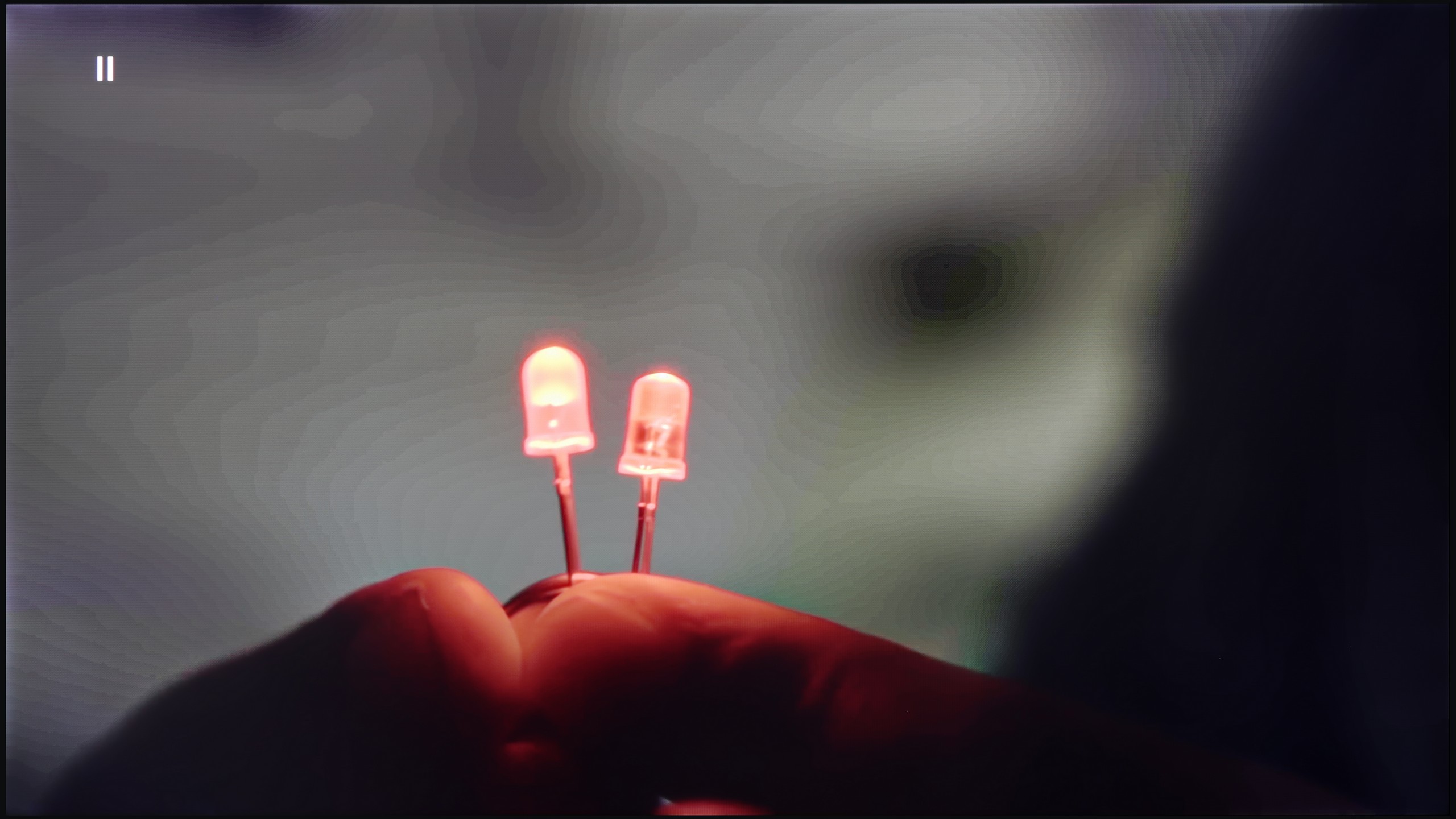
Image without overscan on the SD signal


With high-quality materials, such as 4K, tonal transitions on the U6NQ look really good – the colours blend nicely and the image is cohesive. Unfortunately, when we switch to content in a lower resolution, the television does not offer any additional features that could improve this aspect. An example is the test with the light bulb, where it is clear that the television has trouble rendering subtle tonal transitions.
On the other hand, digital processing performs quite well. The image looks plastic, pleasantly soft, and free of excessive aliasing. Moreover, thanks to the sharpness settings, it can be adjusted according to personal preferences – whether towards a softer or sharper image. Overall, although scaling lower-quality materials could be better, the television does well with image processing.
The LS03F is equipped with the NQ4 processor, which is responsible for improving image quality—especially in lower-quality materials. In practice, it works surprisingly well, particularly with older content and recordings with lower resolution. Activating the "noise reduction" feature yields noticeable effects. The television effectively smooths tonal transitions and removes digital noise that can appear in darker areas of the image. Compared to previous generations, there is a clear improvement—previously, this feature often smoothed everything too much, including details that it shouldn't have removed. In this year's model, the smoothing still occurs, but it is done in a much more acceptable manner. Textures of materials, skin, or fabric details are no longer so heavily muted as before—the image retains more naturalness. However, this does not change the fact that film grain is still removed by the television, which may not be to everyone's liking. On the other hand, it is no longer as aggressive an intervention as in previous models. It is also worth mentioning that the LS03F may struggle with very weak signals—such as recordings from VHS tapes or video in low resolution. In such cases, we noticed slight clipping of the image at the edges—so-called overscan. This can lead to situations where a small part of the image (e.g., subtitles at the bottom edge) gets cut off.
Blur and motion smoothness
3.4/10
6.9/10

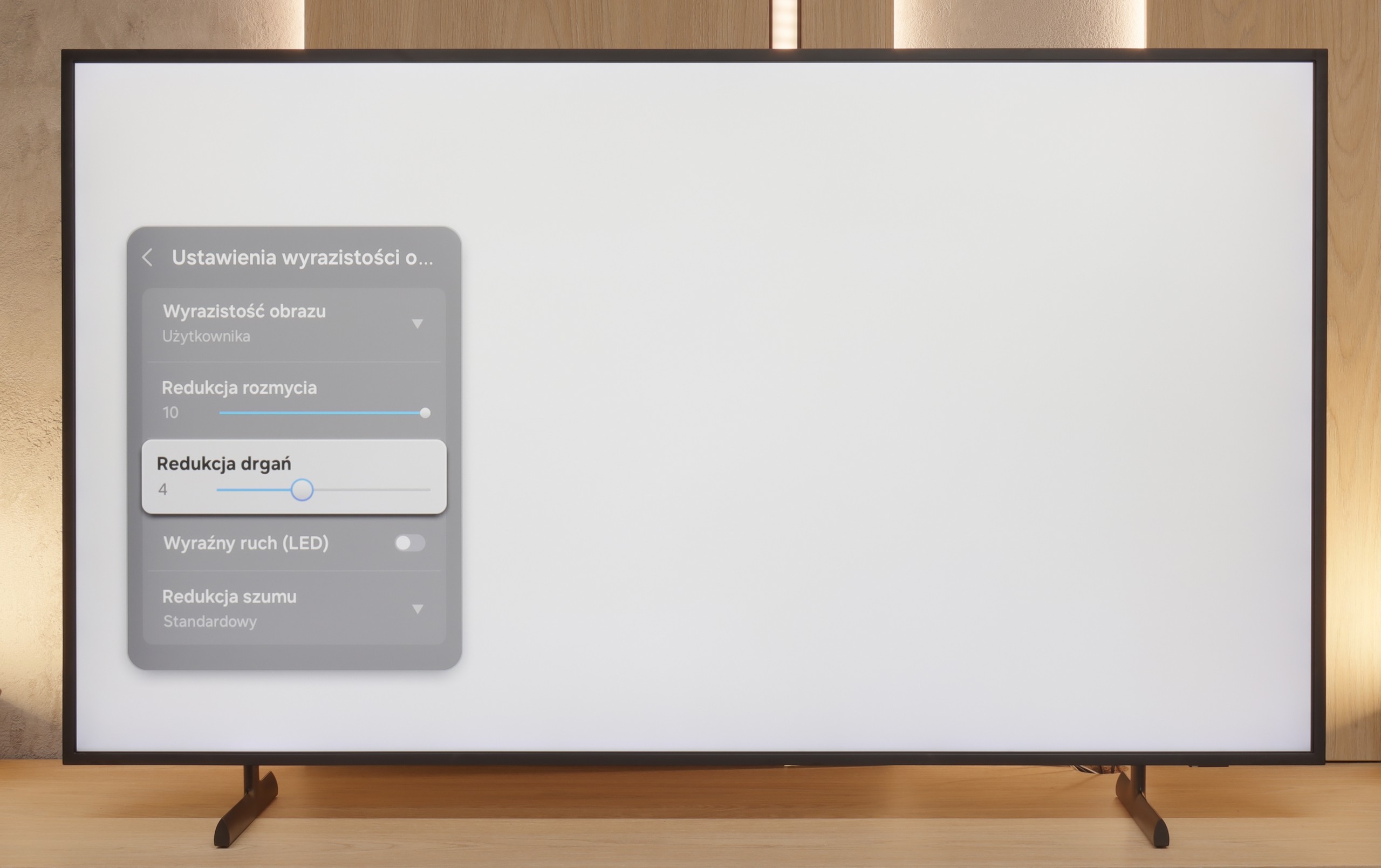
Blur (native resolution, maximum refresh rate):






Blur (BFI function enabled):
Image flickers in this mode



The Hisense U6NQ offers a native refresh rate of 60 Hz at a 4K resolution, but the manufacturer has added a feature that allows increasing the refresh rate to 120 Hz at the cost of reducing the resolution to Full HD. This is a solution we have seen before in TVs from TCL, such as the C655 and the C655 PRO. This gives the user the option to choose – higher motion fluidity or full resolution. This is a sensible approach, especially considering that many games on new-generation consoles do not achieve full performance in 4K at 120 Hz.
As for movies, the TV is equipped with a motion smoothing feature that allows adjusting motion characteristics to personal preferences. This can create a more cinematic effect or increase fluidity in dynamic scenes. Overall, the Hisense U6NQ offers reasonable solutions for motion fluidity that should satisfy both gamers and movie lovers.
A novelty in The Frame for 2025 is the panel with a refresh rate of 144 Hz. Yes – in a television primarily associated with displaying artwork, you can now not only watch Van Gogh but also comfortably play on a console or follow dynamic sports action. This is a definite step towards greater versatility. In the case of Samsung films, as usual in models with a 120 Hz panel and above, it allows you to adjust motion smoothness according to your own preferences. You can set a more cinematic representation while maintaining frame rate or opt for full motion smoothing. The range of options is wide, allowing you to tailor the effect to your taste – whether the viewing experience is meant to resemble classic cinema or a presentation on a modern theater panel.
*this part of the test refers to the model LS03FAU in sizes 55 and 65 inches, which is equipped with a 144Hz panel; the 43 and 50-inch sizes have 60Hz panels, and therefore perform much worse in terms of motion smoothness.
Console compatibility and gaming features
6.3/10
8.1/10
- ALLM
- VRR
- VRR range48 - 60Hz48 - 144Hz
- Dolby Vision Game Mode
- Correct implementation of HGIG
- 1080p@120Hz
- 1440p@120Hz
- 4K@120Hz
- Game bar

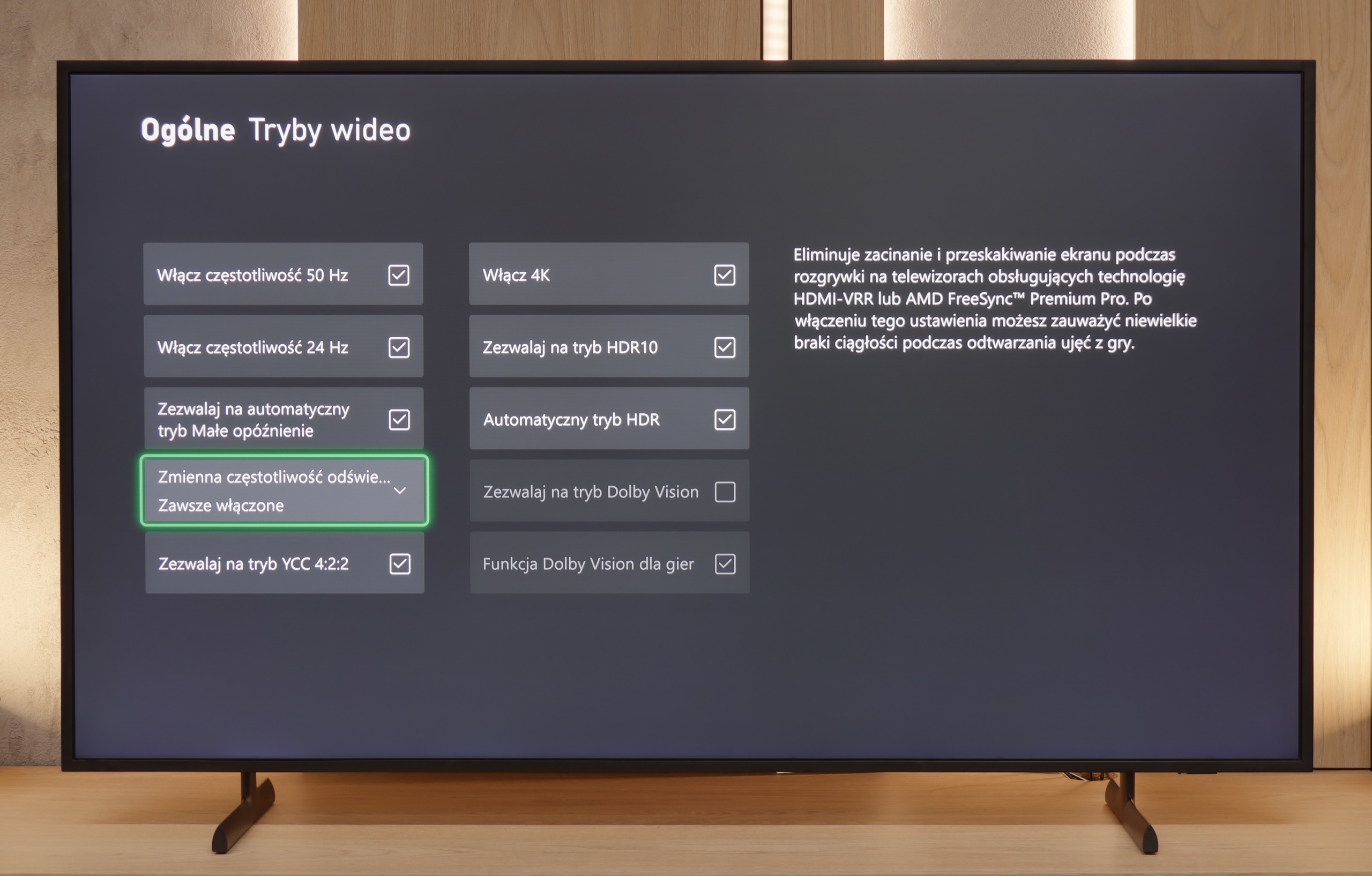

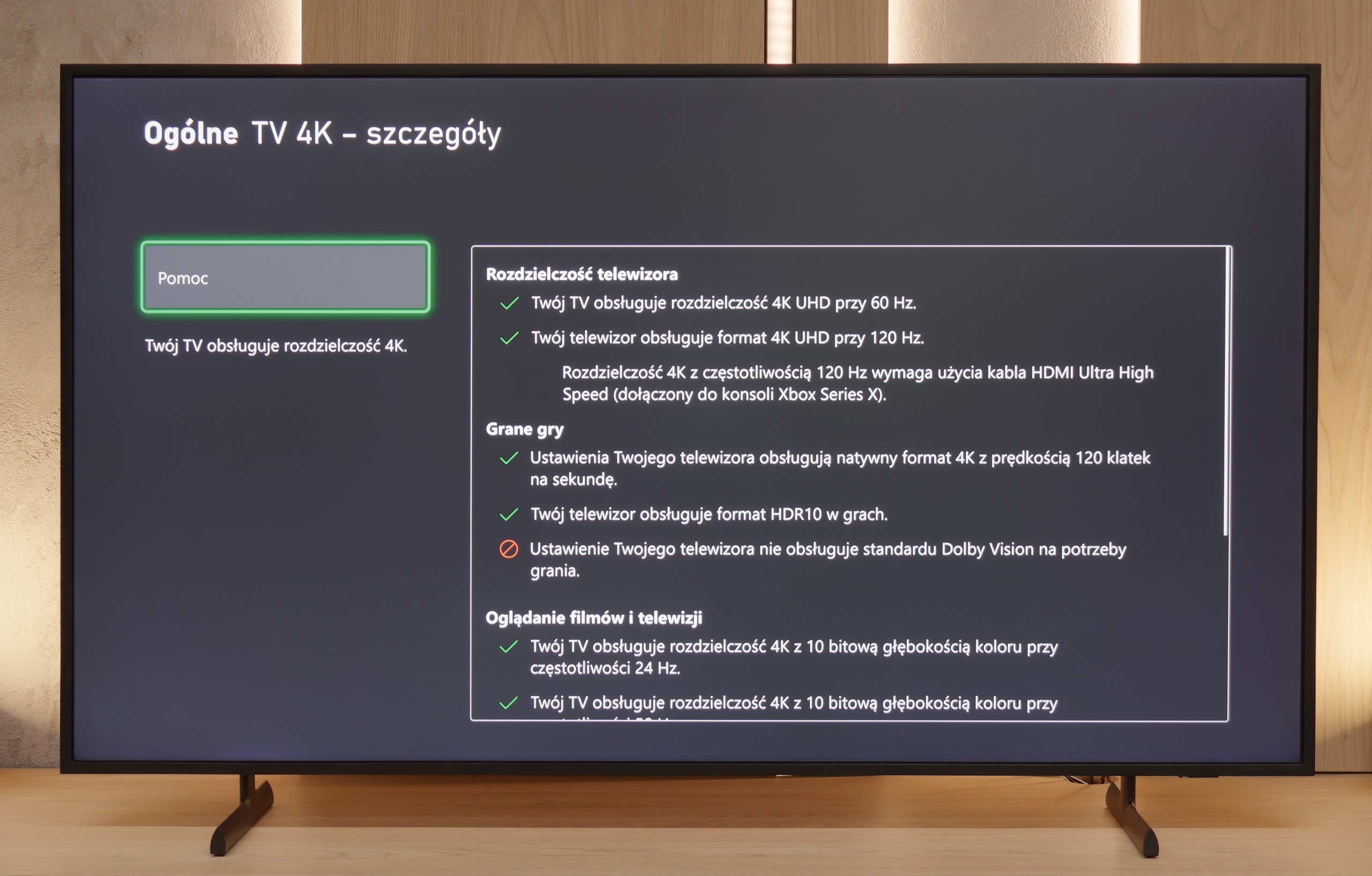



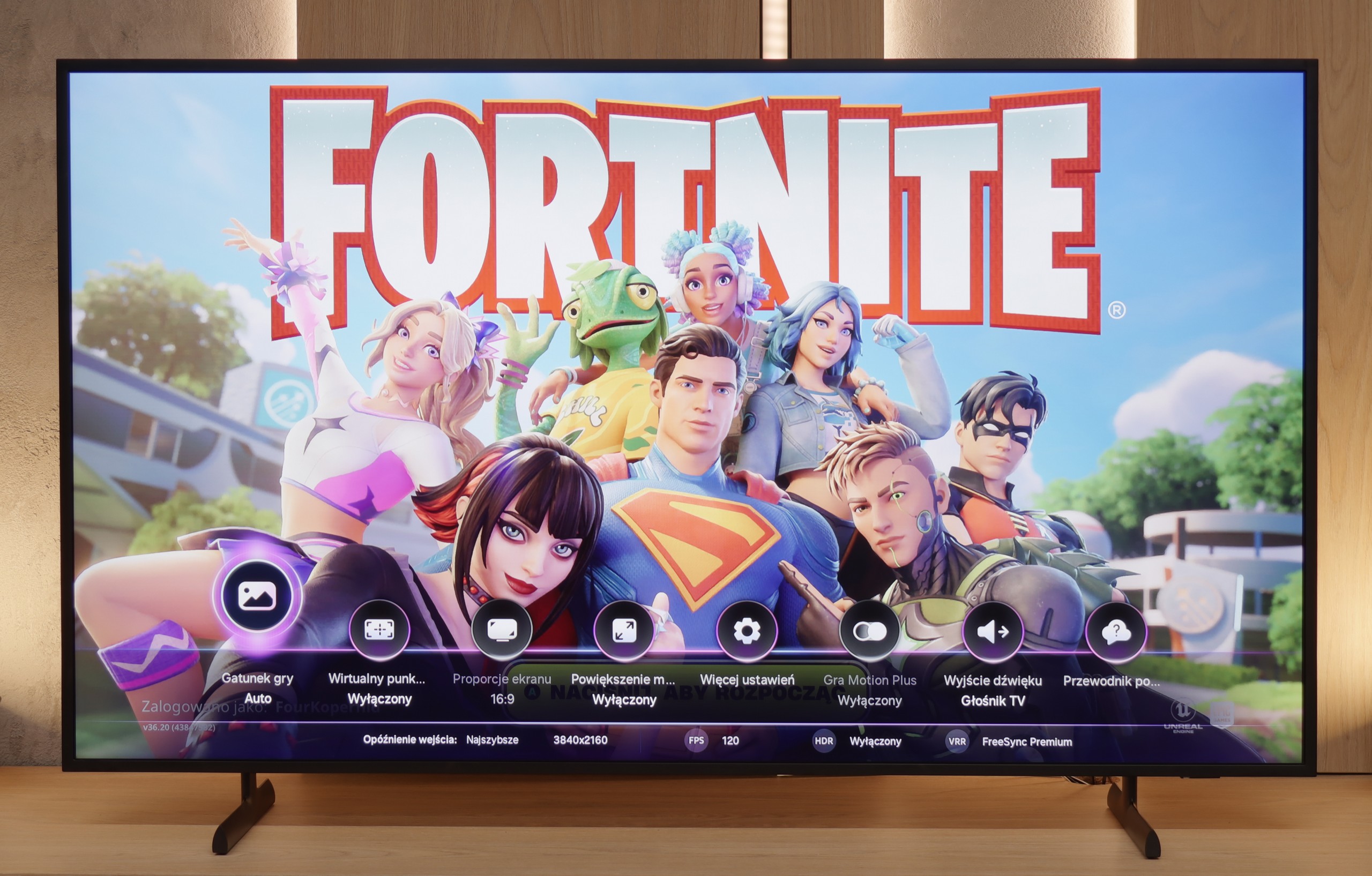
The Hisense U6NQ offers the option to choose between 4K at 60 Hz and Full HD with a refresh rate of 120 Hz. This solution may appeal to gamers who want to decide what is more important to them – higher resolution or smoothness. The television supports features such as ALLM and VRR, which help in achieving smoother gameplay. A nice addition is the GameBar – an easy-to-use panel that allows for quick changes to picture settings and checking statistics. It also includes a Dolby Vision Gaming mode, which works with low input lag, a big plus for console enthusiasts. Unfortunately, it lacks HGiG, which could further enhance HDR quality in games. Nevertheless, the Hisense U6NQ performs quite well as a gaming television, especially for those who play occasionally and do not require the highest refresh rates in 4K. It is a solid choice for less demanding users.
As we mentioned earlier – although The Frame likely displays images and works of art most of the time, Samsung has recognized that a Van Gogh enthusiast can just as easily be an avid gamer. And it must be admitted that The Frame 2025 has almost everything it needs to become a fully-fledged gaming television.
On board, we find support for ALLM (automatic game mode) and variable refresh rate (VRR) thanks to the implementation of one HDMI 2.1 port. The television handles lower resolutions at higher refresh rates without any issues and features an expanded Game Bar – already known from other Samsung models – which allows for quick previewing and changing of the most important gaming-related settings. For this, it earns additional points from us. The proprietary motion smoother Auto Motion Plus Game also deserves special mention, which – and it's worth emphasizing – works without increasing input lag. Samsung remains the only manufacturer that has managed to implement this feature in a practically noticeable way in terms of delays. The result? Much better fluidity in games, especially those that struggle to maintain stable 60 frames. This solution can realistically improve the gaming experience in more demanding titles – especially on consoles that don’t always manage full fluidity, especially in AAA games.
As for the downsides – the lack of Dolby Vision is already considered standard in Samsung televisions, so there's nothing to particularly complain about here. However, the problem is something entirely different. In the latest version of the Tizen system, the HGiG option has disappeared. Literally – it's not there. This is a significant setback when configuring a console for proper HDR content display in games. It’s hard to understand why such a decision was made, but one thing is certain – this should be fixed as soon as possible. We are talking about a brand that has set standards for gaming on televisions for years. If HGiG comes back – and we hope that it will – The Frame LS03F can confidently aspire to be a true gaming television. Not just as a decoration on the wall, but as equipment that really provides joy in gaming.
Input lag
9.9/10
10/10
SDR
HDR
Dolby Vision
The Hisense U6NQ TV offers a very low input lag of 14 ms, making it a good choice for gamers, especially those who prefer dynamic titles. It's also worth noting that the Dolby Vision mode in games works really well here. This is a pleasant surprise, as on many other televisions this HDR mode performs only averagely.
In terms of input lag, Samsung maintains a high standard – and it's a very high one. The LS03F, like most of this year's models from this brand, achieves a score of 8 ms for 4K content, which is almost a reference value. This result allows you to play even the most dynamic titles without delays and with full responsiveness. Well done!
Compatibility with PC
6/10
8.2/10


As a screen for working with a computer, the Hisense U6NQ performs quite decently. The fonts are readable enough, so it's sufficient for everyday writing or browsing the internet.
When it comes to gaming, the television supports G-Sync, but only at 4K resolution at 60 Hz. Unfortunately, if someone was counting on 120 Hz smoothness in 1080p with G-Sync enabled, they might be disappointed – the television does not offer this. It's a bit of a shame, as it could have been a good solution for gamers who prefer smoothness over resolution.
The collaboration of The Frame 2025 with a computer poses no major issues. Let's start with gaming, as this is where this model shows its strengths – support for a 144 Hz signal, low input lag, and compatibility with G-Sync technology (for NVIDIA cards) make it hard not to consider it a fully-fledged gaming monitor. It is one of the more interesting "PC gaming" TVs available on the market in this class.
When it comes to daily work, the situation looks just as good. The Frame easily handles chroma 4:4:4, which translates to good font readability and overall user comfort. We only noticed minor issues with dimming very thin lines and dark details on a bright background – this effect may occur particularly when working with small interface elements. However, in practice, with a 55-inch screen and standard office working distance, it will be difficult to notice this problem realistically. Nonetheless, it's worth keeping this in mind if the television is to serve as a monitor not only for entertainment but also for precise work with graphics or text.
Viewing angles
3/10
3.5/10
The viewing angles on the Hisense U6NQ are average, which is typical for VA panels. This technology offers better contrast and deeper blacks but at the expense of image visibility at wider angles. It's a classic compromise – in TVs with IPS panels, the situation is reversed, where the viewing angles are wider, but the contrast and blacks suffer in quality.
As one could expect from a VA panel, the viewing angles on The Frame 2025 are at best average. The image loses saturation and contrast when viewed off-angle. It’s a pity, because we are talking about a model that displays digital artworks while in standby mode—and it is precisely in such moments that wide viewing angles would make the most sense, enhancing the feeling of being in the presence of a real image, rather than just its screen imitation.
Perhaps in the future, manufacturers will decide to introduce special coatings or modified versions of VA panels that will improve this aspect—because in the case of lifestyle televisions, it would have real significance not only in terms of usability but also aesthetics.
TV efficiency during daytime
6.1/10
6.3/10




Matrix brightness
Average luminance SDR
Samsung The Frame 2025 (LS03F): 596 cd/m2
Hisense U6NQ: 488 cd/m2
The Hisense U6NQ performs well in bright rooms thanks to the satin finish on the panel, which effectively suppresses reflections. The average brightness on SDR materials, such as standard television, is 488 cd/m², which is more than sufficient for comfortable viewing even in somewhat challenging lighting conditions.
One of the most characteristic features of The Frame is its matte display – and it must be admitted that Samsung has really refined this aspect. From our experience, this is one of the best solutions for reducing reflections, especially direct ones. If reflections on the screen can be irritating, it will be hard to find a better display in this budget than the matte panel used in Samsung TVs. Of course, this comes with a certain compromise. In very strong sunlight, colors may appear slightly washed out, and the image loses some depth. However, this is something we consciously accept when choosing a matte screen – something for something. In practice, the colors and contrast on Samsung's matte screen still perform better than on Chinese models like TCL NXT Vision or Hisense Canvas TV. If effectively reducing reflections and the desire to use the TV also as a 'digital picture' in bright rooms are priorities, it’s hard to find a better choice.
The Frame achieves about 600 nits of brightness, which, combined with the matte coating, allows the TV to handle well-lit daytime conditions without any issues. It may not reach the level of flagship models, but in everyday use – in a living room with plenty of light – it performs seamlessly.
Details about the matrix
Subpixel Structure:

Panel uniformity:


TV features
9/10
8/10
- SystemVIDAATizen
- TV receptionDVB-T, DVB-T2, DVB-S, DVB-S2, DVB-CDVB-T, DVB-T2, DVB-S, DVB-S2, DVB-C
- Recording to USB (terrestrial TV)
- Recording programming
- Picture in Picture (PiP)
- Screen mirroring (Windows Miracast)
- AirPlay
- Voice search in native language
- Ability to connect a keyboard and mouse
- Possibility to connect Bluetooth headphones to the TV
- Possibility to simultaneously use Bluetooth headphones and the TV speaker
- Audio only mode
- RF remote control (no need to aim at the screen)RFRF
- Backlit remote control
- Teletext


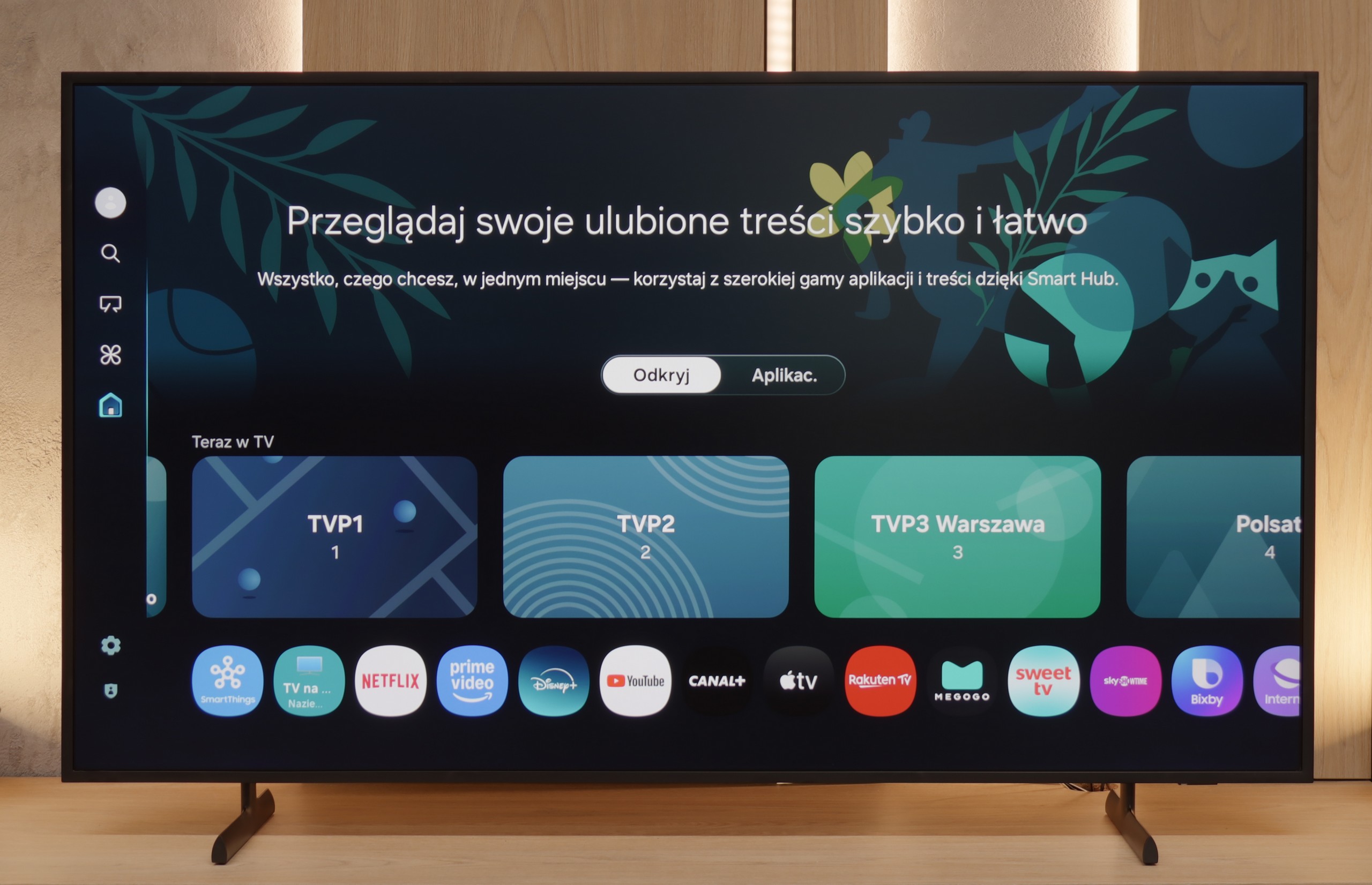
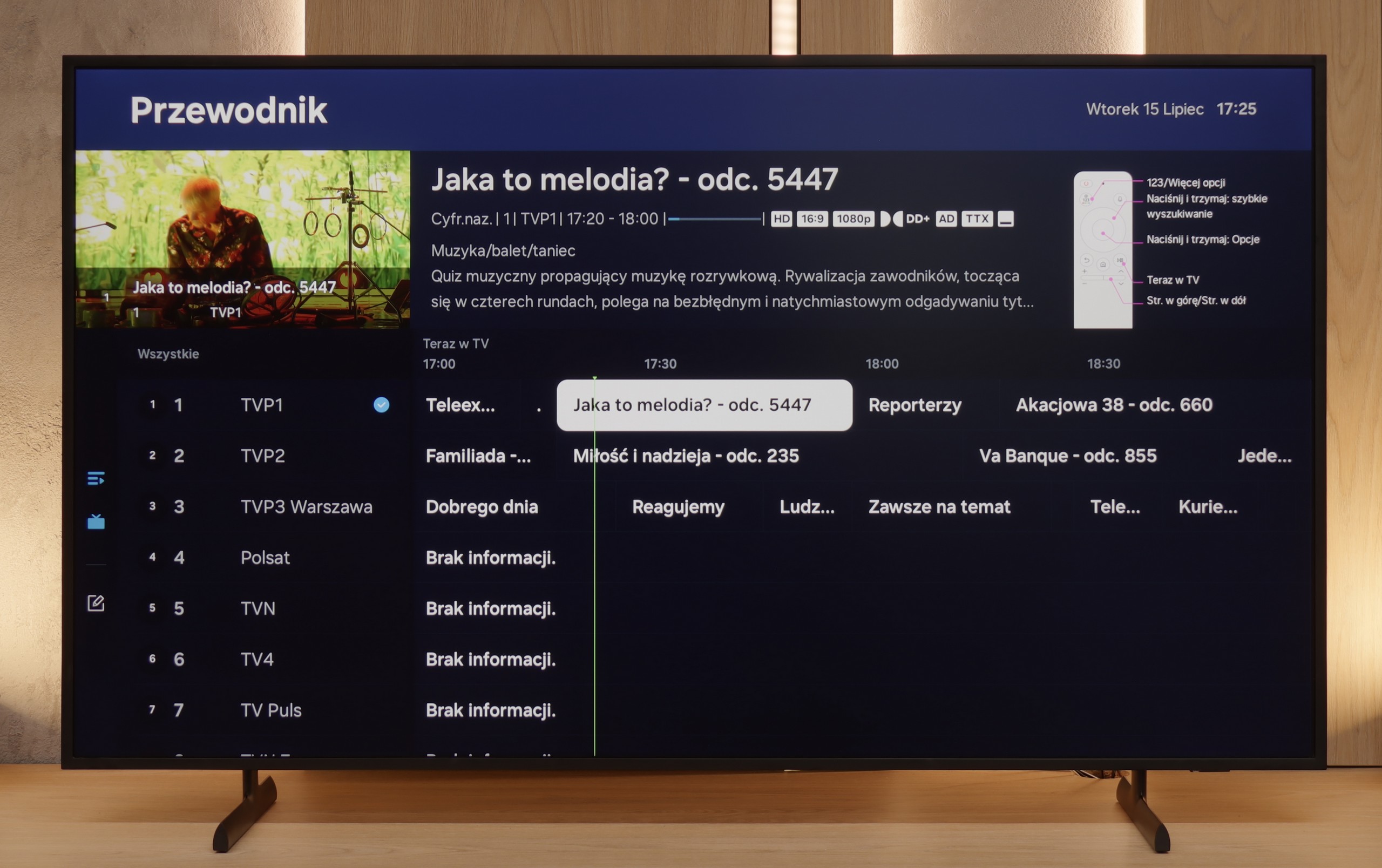

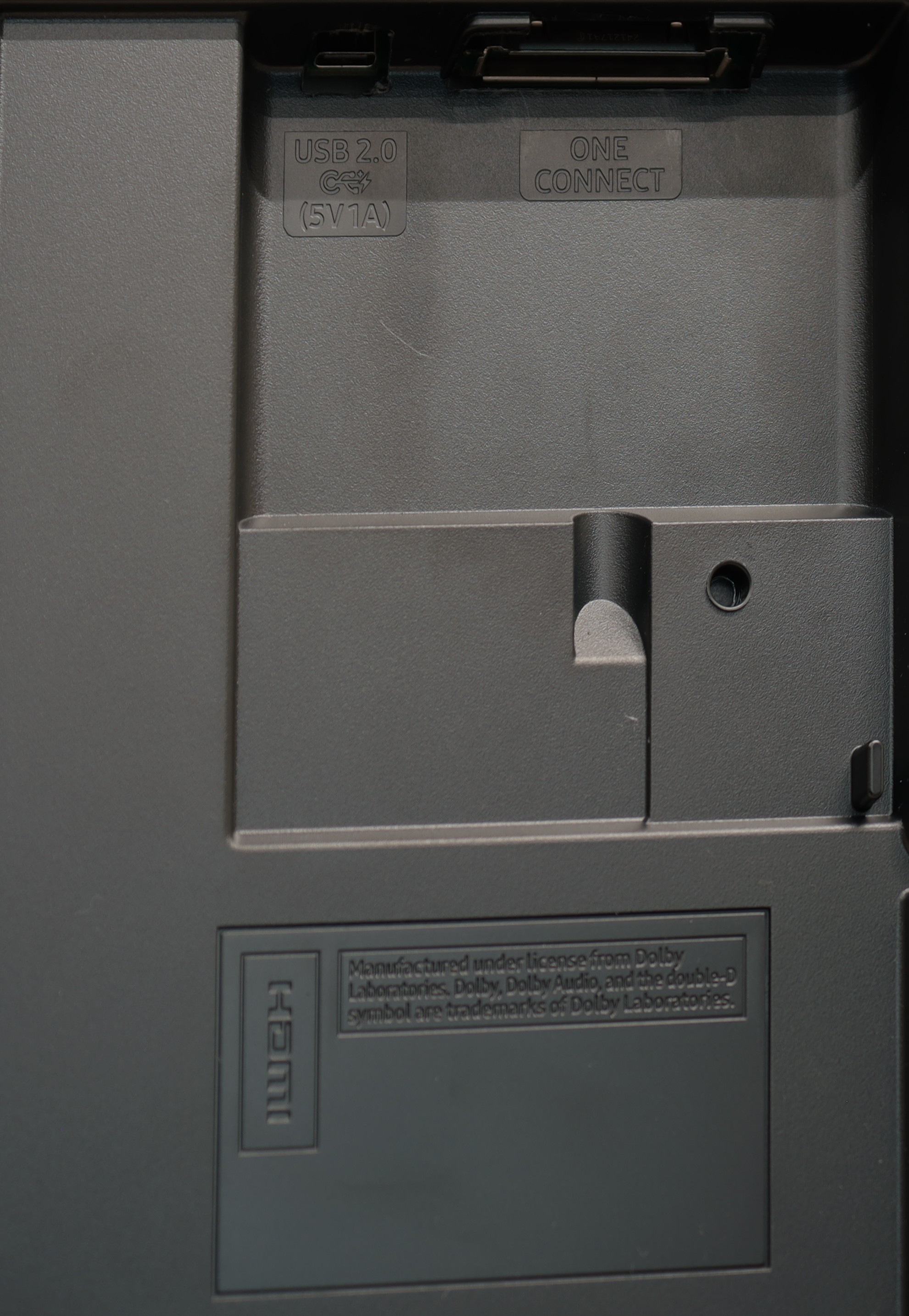
The Vidaa system that powers the Hisense U6NQ is probably one of its stronger points. It is fast, runs smoothly, and most importantly – doesn't suffer from any stuttering that can be frustrating on other televisions. It's nice that you can use voice search, which significantly simplifies operation. There are quite a few apps available, but unfortunately, there are no music apps like Spotify or Tidal. It’s a pity because a TV is not just for movies and shows – some would probably also like to use it for listening to music.
Among the additional features, we have the ability to record TV programs on a USB drive or external hard drive. There is also AirPlay and Miracast, so it's easy to stream content from a smartphone. The built-in Bluetooth is also useful, allowing you to connect headphones, a mouse, or a keyboard. The only thing that is really missing here is the PiP (picture-in-picture) function. If it were added, the TV would be complete for features. Nevertheless, the Hisense U6NQ offers plenty and should be sufficient for most users.
Classic TV Features
In terms of classic features, The Frame does not stand out in any way compared to the competition. There is no USB recording option or PiP (picture in picture) feature, which may be disappointing for some users. On the other hand, the TV allows for simultaneous use of speakers and headphones, which can be useful – especially for older users. The EPG, or electronic program guide, is quite readable, and despite the lack of traditional buttons on the remote, we managed to launch even the teletext. In everyday use, the basic functions work smoothly and without significant complaints.
Smart System – Tizen and Apps
The Frame 2025 runs on the Tizen operating system, which has been considered one of the most refined Smart TV solutions on the market for years. It is a system designed for devices that are more than just a television – and it was created with that spirit in mind. Tizen offers full integration with external devices – supporting both Apple AirPlay and Miracast. With the SmartThings app, it is possible to control not only the television but also other devices within the smart home. Since last year, Samsung has also been developing its own voice assistant with support for the Polish language, which significantly facilitates operation. However, the greatest strength of the Smart system in The Frame remains the Art Gallery app. Although access to it is paid (via subscription), it offers the best art scans on the market – we are talking about scans, not just ordinary photos. As a result, the effect of a digital artwork hanging on the wall looks much better than in any other lifestyle TV.
Playing files from USB
8.5/10
8.5/10
Supported photo formats:
Maximum photo resolution:


The built-in file player in the Hisense U6NQ should satisfy most users. It supports Polish characters and allows easy editing of displayed subtitles, which is a big plus. Unfortunately, it lacks support for the AV1 codec, which may be an issue for those looking to play newer video formats. However, for less demanding users, the player’s features will be fully adequate.
During testing, we did not notice any major problems with playing files from a USB memory. The TV handled both video materials and photos well. Of course, there are some exceptions – for example, lack of support for the HEIC format (used by Apple devices) – but it’s hard to consider this surprising. On the plus side, there is full support for high-resolution photos – the TV displays files with a high number of megapixels without any issues, which may be particularly important for those who want to treat The Frame as a digital frame as well. However, during testing, we noticed a limitation regarding subtitles – the TV only properly handled files in the .txt format. It's worth keeping this in mind and ensuring that the downloaded subtitles for movies are saved in this format, otherwise they may simply not display.
Apps
8.6/10
8.3/10














































Sound
6.3/10
6/10
- Subjective sound quality:6.3/106/10
- Dolby Digital Plus 7.1:
- Dolby True HD 7.1:
- Dolby Atmos in Dolby Digital Plus (JOC):
- Dolby Atmos in Dolby True HD:
- DTS:X in DTS-HD MA:
- DTS-HD Master Audio:
The Hisense U6NQ is equipped with a standard set of speakers with a power of 20 W, which is a typical solution in this class of TVs. The sound is decent but nothing particularly special. However, it is worth noting the support for all popular audio codecs, including DTS and Dolby Atmos. This allows for easy connection to a home theatre system or soundbar, resulting in significantly better audio experiences than the built-in speakers.
For such a slim TV, the sound is quite good. It's full, sufficient for everyday viewing, but without much excitement – typical for flat designs. There's not much bass, although at times it can be heard. The speakers in a 2.0.2 configuration have a total power of 40 W (in the 55+ inch version). Unfortunately, the TV does not support DTS format, so when watching films with that audio, external equipment, such as a home theater system, must be used. You can connect a soundbar, and thanks to the Q-Symphony feature, the TV plays along with it. Samsung also offers visually matching models to The Frame like S700D or S800D, but they are sold separately. (This shouldn't surprise anyone😉).


